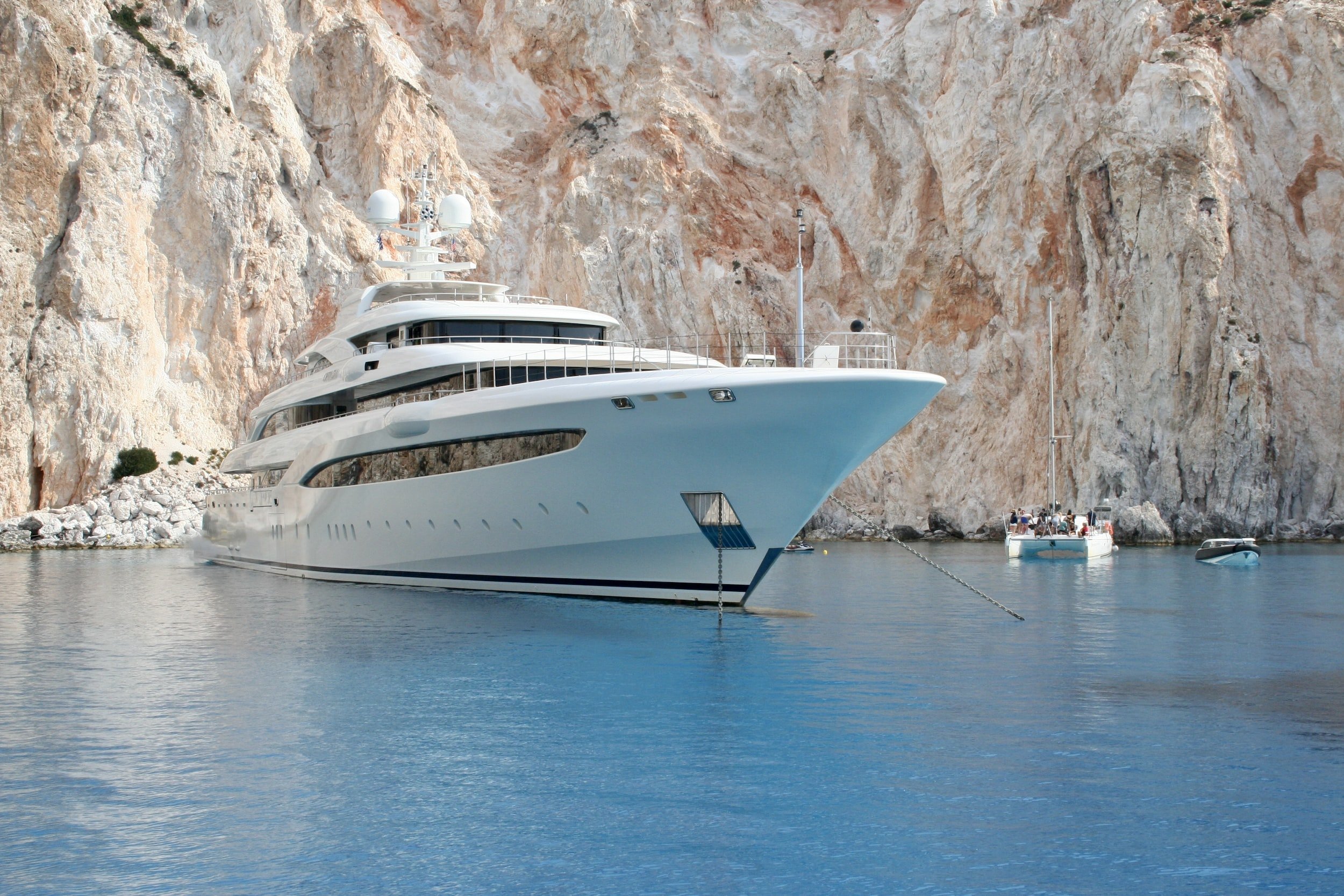A deep dive into the world of superyachts
With demand for superyachts at an all-time high, we take a look at the reasons behind this, the current trends, and what the future holds
The travel industry may have taken an unprecedented knock as a result of the pandemic, brexit and political unrest, but there is one area that is booming: superyachts. The demand for these highly luxurious vessels has not only surged in the last 18 months, it has exploded. The industry is also simultaneously undergoing something of a metamorphosis. The super-rich are spending longer at sea, and – as such – superyachts are transforming from a holiday retreat into a floating home from home. Albeit homes which deliver the ultimate luxury experience.
At time of writing, the only obvious cloud on the horizon is the uncertainty regarding the knock-on effect of Russian sanctions on the superyachting industry. With a large proportion of the world’s superyachts being Russian owned, they won’t be able to sail in European waters. But this also means that non-Russian crews on those vessels will be seeking employment elsewhere, and there will be a halt on building and refitting of Russian-owned yachts, affecting the workflow of shipyards and other support industries.
The situation is changing daily, so it’s impossible to say how this will play out. However, after emerging stronger from the pandemic, there’s every reason to be positive about the ultimate outcome for the superyacht industry. Therefore, in the midst of this still busy time for all those in the business of designing, building, delivering and managing superyachts, it felt like a good moment to take a dive into this fascinating world. In the following article, we’ll see how the industry is currently operating, and speculate as to what the future might hold. Firstly, though, some basics:
How do you define a superyacht?
Superyachts come in a huge range of sizes and types. But the basic requirement is that the yacht must be over 24 metres long to be ‘super’, and the largest market is for boats between 24 and 50 metres. These might be production boats, where you go to a shipyard or broker and seek out the one you want. Or they might be semi-custom, where the technical package and hull is standard, but you can put your own stamp on the interior. The fully bespoke route is yachts of 60 to 100 metres and more, and – as the name suggests – their design starts with a blank sheet of paper.
What is the role of the owner’s representative in this process?
“When you’re buying a superyacht, you need an owner’s representative to oversee the construction, to ensure all regulations are met, and to keep variations on the contract to a minimum,” explains Derek Munro, director of Divergent Yachting, specialist in yacht project management. “Changing your mind on any detail – whether it’s the type of windows or the design of the bar – will cost time, and therefore money, at the shipyard if it’s done after the contract has been signed.”
The owner’s representative ensures that payments are made in the necessary stages, and also that the shipyard has met the requirements expected at those stages. The yacht must fulfil the aesthetic brief, but must also be fit for purpose, and the representative oversees that too. “For example, if you put a dining table onto a yacht, you need to see its design at the very beginning, so the shipyard can make sure the steel plates underneath the legs are thick and strong enough for it to be bolted down safely,” continues Derek. “So, when the boat rolls off a wave and tilts 20 degrees for a brief moment, the furniture won’t fly around and cause damage or injury.”
What other unique challenges are there in creating a superyacht?
Creating a concept for the yacht isn’t actually that different from designing for an interior in a home on land, but other factors must be carefully considered, as Sarah Colbon, co-founder of superyacht interior design company Njord by Bergman Design House, points out. “This is a floating vessel, so weight limitations are very important when choosing materials. Also, energy usage is key when selecting fixtures and fittings, because for a lot of the time, you have to generate power and be self-sufficient when the boat is out at sea. Finally, a yacht isn’t solely a place of leisure, you must also take into account the needs of the crew who will live and work here.”
Jason Chadda, director of bespoke furniture maker Silverlining Furniture Group, agrees there are many similar considerations between marine and land-based projects. “But one of the things pertinent to yachts is vibration. You need to ensure that a teaspoon isn’t clattering in its saucer as soon as the boat is underway. In addition, you need to select materials that can cope with sea and salt, as well as extreme fluctuations in temperature without moving or cracking.”
How has the pandemic affected what clients ask of a superyacht?
With other holiday destinations out of commission during the pandemic, those with yachts began spending more time on board than ever before. And they quickly discovered that, for example, they didn’t have sufficient storage or correct lighting for everyday living.
Even specially commissioned furniture had to earn its place by performing more than one function, as Jason Chadda explains. “We’ve created desks that fold out into a meeting table, and coffee tables that transform from a space for drinks to a bar table. Furniture must also be suitable for use both indoors and outdoors too.”
“In addition, we found that people began to expect something different from their lives on board,” adds Sarah Colbon. “Rather than the yacht being solely an entertainment space, they wanted more wellness, so we were being asked to add facilities to incorporate their fitness regimes.”
In common with everyone during the pandemic, the yacht became a workplace for many owners. “People are using their yachts more like offices, so we’re having to install a small business network into these crafts,” says Rex Barrett, projects director for integrated entertainment systems specialist Ideaworks. “Communication is much more of a challenge on a yacht, though, as the internet and phone are via satellite – 5G only works when you’re within range of the coast.”
How has the increase in superyacht sales impacted the industry?
The increased demand for superyachts can be attributed to people investing for the first time, as well as those taking the plunge on a long-considered upgrade. “But in the same way you live in a house for a year or so before embarking on any major projects, new yacht owners are using the boat for a period of time before deciding what their priorities are,” says Rex Barrett. “As such, I think we’re going to see a big boom in the refit sector of our industry in the next year to 18 months.”
Derek Munro agrees. “To build a new superyacht, it takes between three to five years, plus all the decent shipyards have full order books until at least 2025, so the wait is even longer. As such, there’s been a big rise in the sale of second-hand boats, which people are refitting to meet their requirements.”
What are the latest trends in the superyacht world?
The concept of explorer yachts has emerged over the last few years, and – if anything – has increased during the pandemic. People no longer want to take their yacht solely between the Caribbean and the Mediterranean, but are venturing further off the beaten track. As such, yachts are being refitted as sea-going vessels which can withstand longer distances and more extreme conditions.
“In terms of the interior design, explorer yachts need to be equipped for sailing to those far-reaching destinations, and we’re talking to a lot of people about that,” says Sarah Colbon. “And, as in so many other areas, we’re being tasked with sourcing eco-friendly and sustainable materials. In fact, we’re currently working on a project where we’re using a lot of bamboo throughout the yacht, plus – appropriately – materials that have been recycled from ocean waste and beautiful fabrics made from seaweed, which is so exciting.”
And finally, what’s coming next?
“From a technology point of view, the biggest single development over the next two to three years will be in communication,” says Rex Barrett. “At the moment, the satellites are very high up and, as such, internet signals are slow and unreliable. With developments such as Elon Musk’s Starlink constellation of satellites, you’ll be able to enjoy the same internet speed onboard as you can at home. And this will completely transform the way yacht owners can work and play, giving them the ability to use video conferencing, stream movies and listen to music.”
Finally, as mentioned above, the next generation of superyacht owners are going to be more adventurous. “And this could see them building boats for a specific task, whether that be kitesurfing or diving, or parking up in Iceland, taking the helicopter off the back of the boat and skiing for the day before popping back for a hot chocolate around the fire,” says Derek Munro. “There’s so much of the world to be seen and enjoyed if you’ve got the right vessel, which has been designed for that purpose.”
At the same time, there is an emphasis on utilising new technology to ensure there is less reliance on fossil fuels, with research on the use of hydrogen and batteries that can store electricity. “Yachts will be designed in a more eco-friendly way, and I think we’ll see some very exciting new ideas coming out of the shipyards in the next five to 10 years,” concludes Derek.
Get in touch
Derek Munro
Director of Divergent Yachting
Sarah Colbon
Co-founder of Njord by Bergman Design House
Rex Barrett
Projects director for Ideaworks
Jason Chadda
Director of Silverlining Furniture Group



